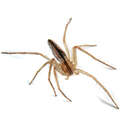en
names in breadcrumbs


Philodromidae, also known as philodromid crab spiders and running crab spiders, is a family of araneomorph spiders first described by Tord Tamerlan Teodor Thorell in 1870 (then known as subfamily Philodrominae within Thomisidae).[1] It contains over 500 species in thirty genera.[2]
The most common genus is Philodromus which is widespread, similar to Ebo.[2] Other common genera include the elongate grass-dwelling Tibellus and the widespread Thanatus, which includes the house crab spider that commonly captures flies on and in buildings.[3]
Philodromids have a crab-like shape due to the first two pairs of legs being oriented sideways (laterigrade).[4] This is superficially similar to the "true" crab spiders (Thomisidae), such as Misumena vatia, but these families are not as closely related as previously thought.[5] Unlike crab spiders, the legs are generally similar in size, though the second leg pair may be significantly longer than the first pair.[4][5] This is most evident in Ebo, where the second pair of legs are twice as long as the first pair in some species.[5] Philodromids have scopula only at the tips of the tarsi (unlike sparassids) and the eyes are in two curved rows with the posterior row wider than the anterior row.[4] In terms of colouration, they are usually cream to light brown and have faint longitudinal stripes.[6]
Philodromidae are active predators and often occur on the stems and leaves of plants.[7] Some occur only on deciduous trees and others only on conifers.[7] A small number of species live in deserts.[7] Instead of building webs to catch prey, they hunt by ambush.[6]
As of April 2019, the World Spider Catalog accepts the following genera:[2]
Philodromidae, also known as philodromid crab spiders and running crab spiders, is a family of araneomorph spiders first described by Tord Tamerlan Teodor Thorell in 1870 (then known as subfamily Philodrominae within Thomisidae). It contains over 500 species in thirty genera.
The most common genus is Philodromus which is widespread, similar to Ebo. Other common genera include the elongate grass-dwelling Tibellus and the widespread Thanatus, which includes the house crab spider that commonly captures flies on and in buildings.